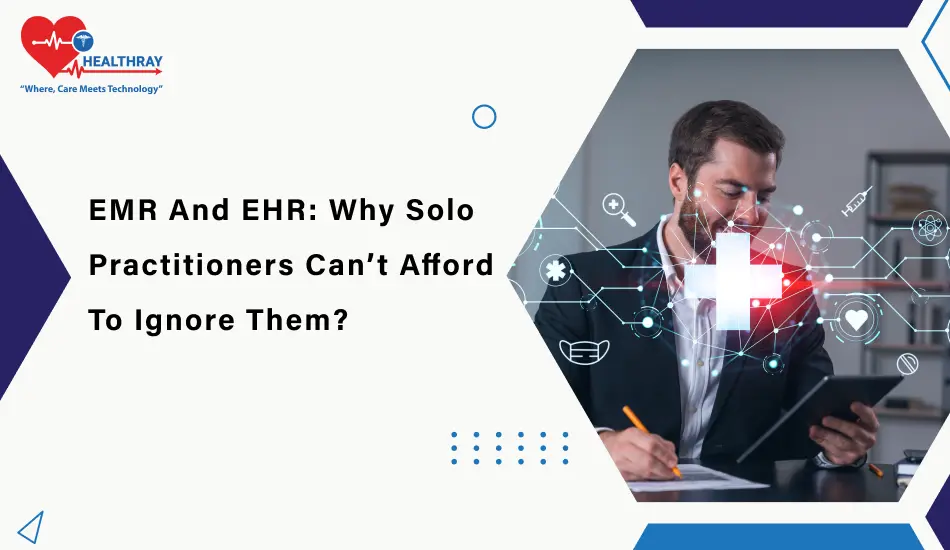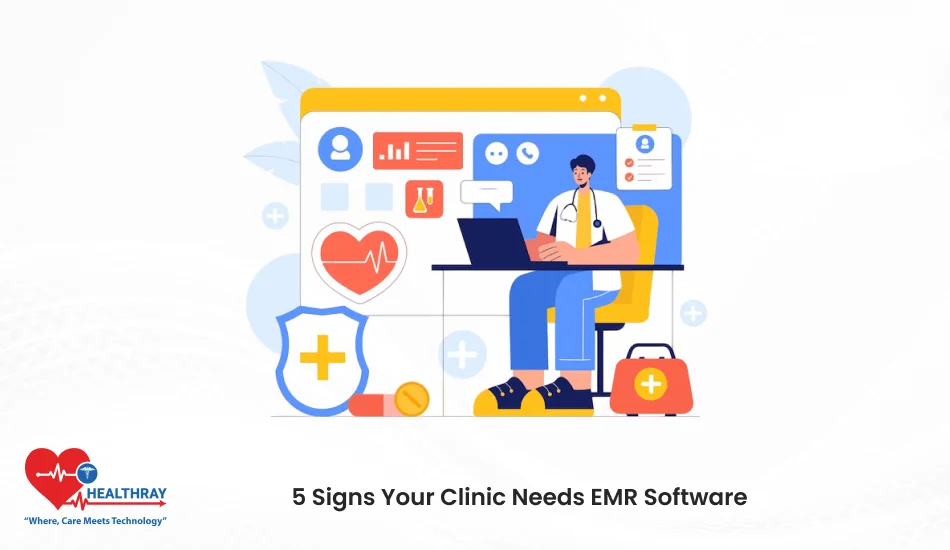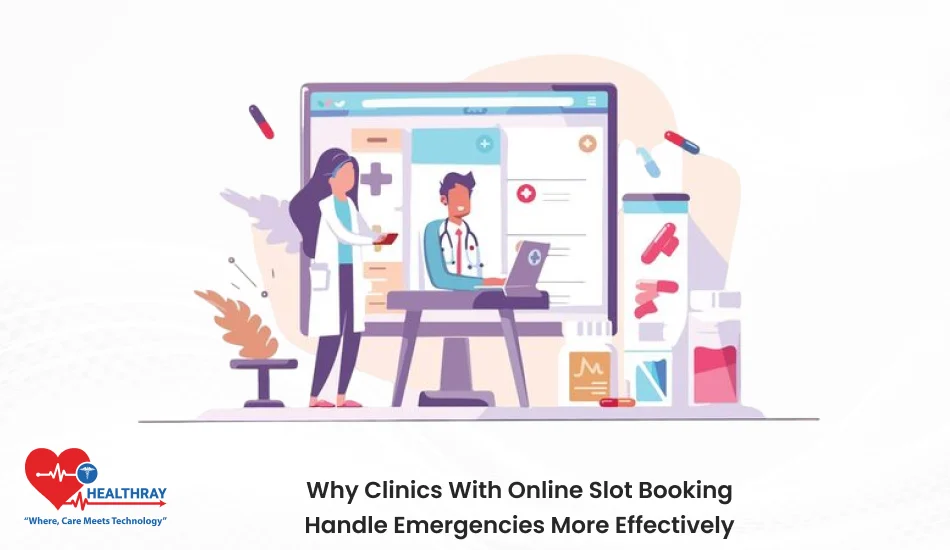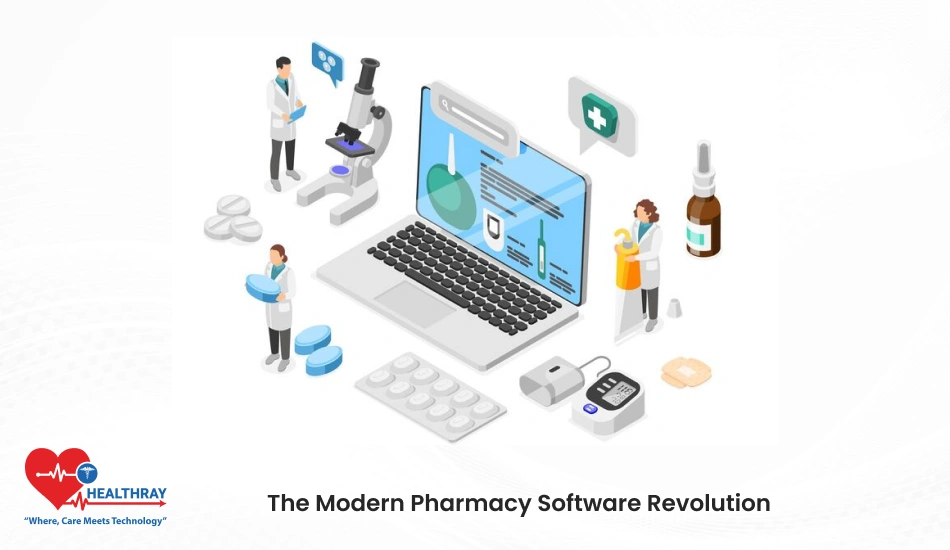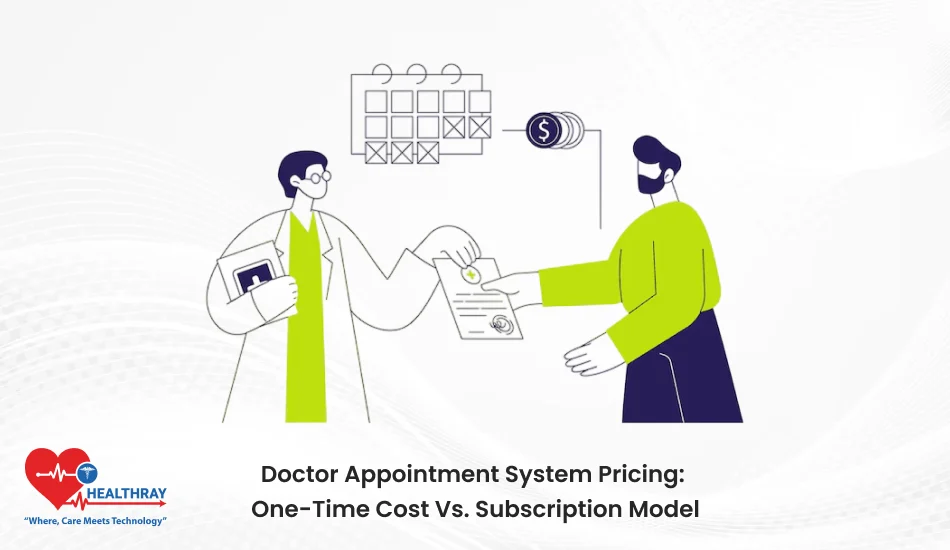A clinic with paper files today is as likely to have a bullock cart in the age of electric vehicles.
Imagine! Dr. Sudhir is struggling with patient charts, sticky notes, and half-filled prescriptions. The waiting room is full, his desk is messy, and he goes down to find a critical lab report. The patients wait, the clock ticks, and the doctor is under pressure.
What if all he needed was just one click away – patient background, lab results, and prescriptions all at one convenient and organized place? That’s the power of EMR systems and cloud-based EHR tools. They swap paper bedlam for speed, organization, and peace.
And in this blog post, we will discuss why solo practitioners just can’t afford to keep these tools off the counter. From saving time and stress reduction to enhanced patient care, we’ll reveal the main reasons these digital systems are not optional but a must for every clinic.
Key Findings and Statistics
- The EHR world market will grow to USD 43.36 billion in 2030.
- 95% of U.S. hospitals already have integrated EHRs.
- 86% of healthcare professionals in the European Union use EHRs in practice.
- The adoption patterns in some regions are high, but not universally across the world. The OECD (2023 survey) found that 15 countries develop electronic health records, and 24 countries have minimum core health information.
What Exactly Are EMR and EHR?
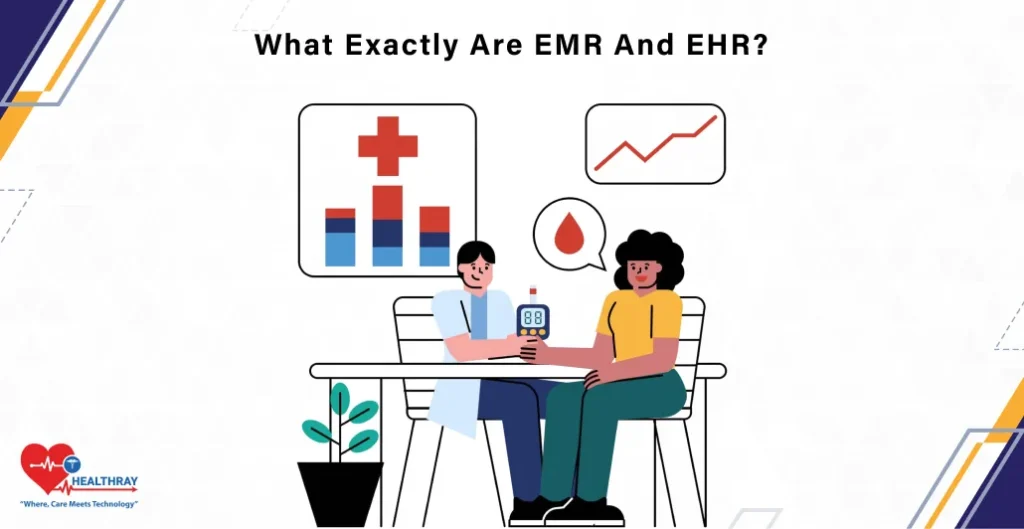
EMRs, or electronic medical records, are the e-copies of paper records that physicians keep in their clinics. They describe a patient’s medical history, diagnosis, treatment strategies, and drugs. These systems not only allow physicians to track the health of their patients over time, but also reduce potential errors that may occur due to illegible prescriptions or misplaced documents.
EHRs (Electronic Health Records) go a notch higher. They are developed to exchange with other clinics, hospitals, or labs at a safe level. Cloud-based EHR systems enable physicians to access patient records in any location at any time, and thus make the process of collaboration quicker and easier.
The main difference is simple: EMR is applied mostly in one clinic, and EHR is involved in the sharing of the information of a patient between disparate healthcare providers. Both electronic health record systems are vital for solo practitioners. EMR helps to organize the everyday patient care efficiently, whereas EHR helps to get the most important information in case of a referral, a laboratory test, or an emergency.
How Can EMR/EHR Improve Daily Workflow in a Solo Practice?
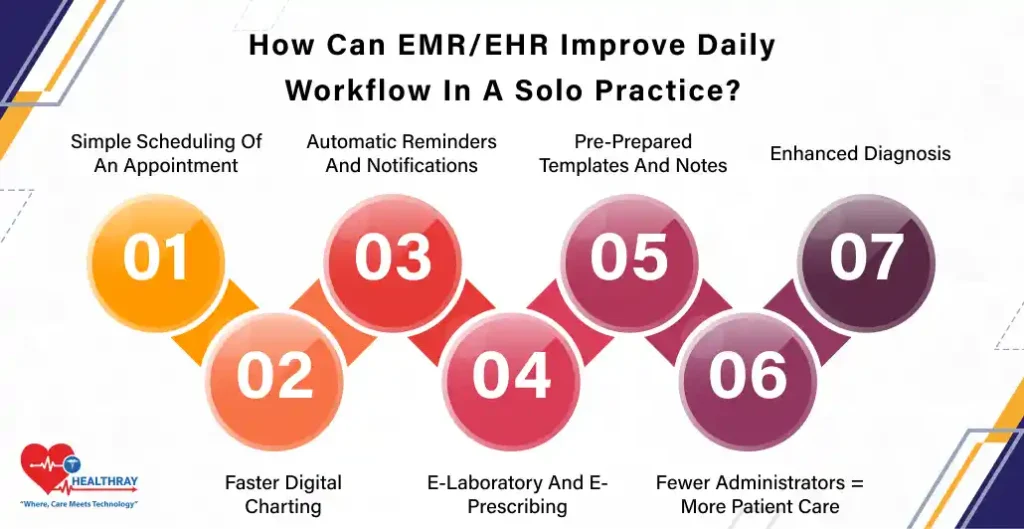
Today, doctors handle all the scheduling of patients up to prescription and follow-ups, all on their own. Cloud-based EHR tools and EMR systems have the potential to make the daily work process faster, smoother, and less stressful in the following ways:
Simple Scheduling of an Appointment
There will be no more cluttered paper calendars or lengthy telephone calls. With electronic health record systems, one can schedule automatically. They can make, reschedule, and cancel appointments online. This wastes no time and puts the clinic on track.
Faster Digital Charting
Handwriting notes about patients is time-consuming and may cause many errors. Electronic Medical Records System enables physicians to make electronic recordings of visits quickly and precisely. Inherent templates ensure simplicity in taking notes. There is no loss of information as everything is put away safely. This assists the solo practitioners to concentrate more on patients than on paperwork.
Automatic Reminders and Notifications
Electronic health record systems are capable of automatic transmission of appointment notices, follow-up notices, and prescription notices. The patients remain on track with their treatment, and physicians do not need to go out of their own way to find them.
E-Laboratory and E-Prescribing
Using the best EMR systems, the prescriptions may be passed to pharmacies directly, and the lab tests may be ordered electronically. Results of the lab are also automatically fed to the patient record. This minimizes calls, faxing, and waiting time so that doctors never have to be inaccurate with their information.
Pre-Prepared Templates and Notes
The majority of top EMR systems have ready-made templates for frequent illnesses and visits. Physicians are able to complete the information within a short time rather than writing it down manually. This saves time, minimizes mistakes, and makes the visit of a patient seamless.
Step towards digital era with our healthcare solution
Revamp your hospital facilities and embrace change for better healthcare management. Ease in managing and organizing large medical datasets leads to effective analysis. Seize the opportunity now!
Fewer Administrators = More Patient Care
Processing of paperwork, appointments, and prescriptions consumes hours on a daily basis. Cloud-based EHR system minimizes administration and saves time, which can be used to treat patients. Individual practitioners can now spend more time with the patients, enhance care, and establish a better relationship.
Enhanced Diagnosis
Proper electronic health records in healthcare imply that physicians can have all the information about patients in a single location: history, medications, allergies, lab test outcomes, and interventions. This helps in improved and faster decision making, diagnosis, and continuity of care.
Why Do Solo Practitioners Continue to Be Reluctant to Adopt EMR/EHR?
Despite the potential easing of life with the EMR systems and the cloud-based EHR, there are still quite a large number of solo practitioners unwilling to take the leap.
One big reason is ‘cost’. Physicians fear that a small clinic would not be able to afford investing in electronic health record systems. The other issue is ‘complexity’. The fact that new software has to be learned, a system of digital charts installed, and labs integrated with it seems to be daunting. It is the fear that the implementation of EMR software will occupy too much time and interfere with the day-to-day operations.
There are also doctors who have ‘misconceptions’. They believe that EMR and EHR are not needed in a solo practice, but only in large clinics. The rest get accustomed to old ways of doing things, like manual billing and prescriptions. To go digital for them is like changing decades of habit.
And lastly, there is the ‘fear of making things worse’. “What if the system crashes? What should I do in case I lose patient records? These concerns cause individual physicians to be reluctant to implement the best EMR in their systems.
The reality is that the current electronic health records in healthcare are tailored towards all sizes of practices. Cloud-based solutions are uncomplicated, safe, and scalable. When the doctors will make the initial step, they will soon understand that EMR/EHR saves time, reduces errors, and offers better patient care – much more than the initial inconvenience and expense.
EMR/EHR Platforms: What Features to Look for As a Solo Practitioner?
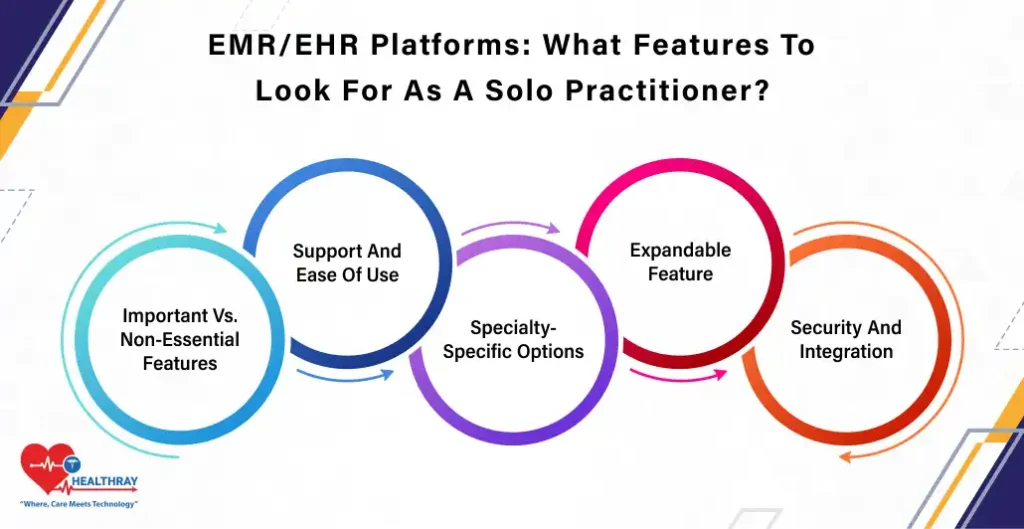
A rightful EMR/EHR platform will help you in reducing errors, saving time, and offering enhanced care to the patients. To make the correct decision, physicians must consider the specifications that are valuable towards routine tasks and long-term developments.
Important Vs. Non-Essential Features
Not everything is a key feature. The must-have features include digital charting, booking appointments, e-prescribing, lab integration, and patient record storage. These are all the characteristics required to have a successful clinic day in and day out.
Moreover, functionalities such as patient portals, automatic alerting, or advanced reporting are convenient but unnecessary at the beginning. Ideally speaking, one should choose a platform that helps operate the clinic at an effective level without being too complex.
Support and Ease of Use
A system that is not easy to operate may slow down the clinic. EMR Systems Software is supposed to possess the interface (UI/UX) with a simple and easy-to-use interface that requires less time to learn. Customer support is also essential in regard to setup and troubleshooting.
The ability to access electronic health records in healthcare via smartphones or tablets on mobile is an added advantage to doctors. This flexibility is important since even individual practitioners who have a tight schedule can be able to run their clinic effectively.
Specialty-Specific Options
Some EMR systems have the best templates and workflows that are specific to a specialty. Such systems accelerate documentation speed and, at the same time, make it more accurate, irrespective of whether the doctor is a general physician or a specialist such as a dermatologist, psychiatrist, or pediatrician. The specialty-based features are time-saving and are based on the best practice concerning the specialty of the clinic.
Expandable Feature
Even a small clinic may grow with time. The electronic health record system should be scalable to allow serving more patients, more staff, or other features without doing a total overhaul of the entire system.
The scalability of EMR systems also means that the clinic will be able to increase in size, and the technology will be there to keep up with the growth of the practice.
Security and Integration
Any clinic needs security. EMR and EHR software that is hosted on the cloud ought to be in compliance with data protection policies within the healthcare sector to make patient records secure.
The good security connections between the labs, pharmacies, billing, and imaging systems allow the transfer of all the information of the patient in a smooth and secure manner.
What Can Solo Practitioners Do to Successfully Switch to EMR/EHR?
The transition to EMR or EHR systems appears daunting to numerous independent medical practitioners. However, it will not cause any disruption to patient care or normal clinical activities. The transition with proper planning can be easy and comfortable.
The initial one is planning the implementation. Begin using the following list of the most important activities that will transition to digital systems: scheduling, charting, e-prescribing, and laboratory integration. Choose the electronic health record systems that can best fit your clinic workflow. One should have achievable time schedules. The process of transitioning does not involve a one-time switch, and therefore, you and your patients should take time to acclimatize to the transition.
Next comes training. Although the clinic may not have any personnel, the doctors may be taught how to use EMR software via tutorials, webinars, or vendor assistance. After the team learns to use its interface, templates, and patient portal features, errors and inefficiencies decrease when the system becomes operational.
Another major step is data migration. The process of transferring patient records that were in paper charts to an electronic system may become overwhelming. Import old records gradually, beginning with active patients and the latest visits. Most leading EMR systems provide functionality to assist in automating this process and reducing errors and wastage of time. Check twice to make sure the entries are correct and maintain a backup until the migration is done.
Lastly, set achievable expectations. The implementation of electronic health records in the health sector is not immediate. At first, tasks can be slower when you are accustomed to computerized work. However, over time, the process of scheduling, documentation, prescriptions, and lab integration will be efficient, quicker, and more precise. The advantages will soon be visible to solo practitioners: less administrative load, improved patient care, and a greater amount of time to pay attention to the important issues.
With these measures, which include planning, sufficient training, clever data transfer, and patience, alone practitioners can manage to transition to EMR systems or cloud-based EHR. It may be a long-term process, but the rewards are many: a well-structured clinic, happy customers, and a stress-free working process.
Conclusion
Solo practitioners are no longer given a choice on whether to transition to EMR systems and cloud-based EHR. The tools make the daily workflow easier, minimize errors, and save precious time, with the doctors being allowed to concentrate on the patients.
Although the transition process might appear to be difficult, proper planning and training coupled with clever data migration can ease the process and make it manageable. Solo clinics can operate effectively, interact more with patients, and expand without pressure with electronic health record systems. Implementation of the top EMR systems will not be a technology upgrade alone, but a leap towards a safer, smarter, and organized practice.
